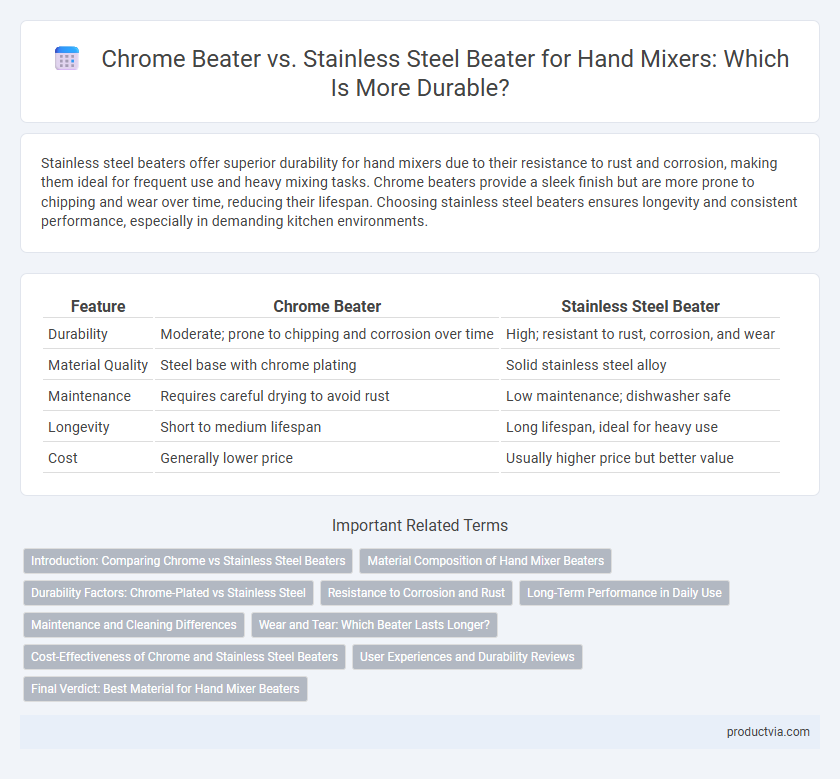Stainless steel beaters offer superior durability for hand mixers due to their resistance to rust and corrosion, making them ideal for frequent use and heavy mixing tasks. Chrome beaters provide a sleek finish but are more prone to chipping and wear over time, reducing their lifespan. Choosing stainless steel beaters ensures longevity and consistent performance, especially in demanding kitchen environments.
Table of Comparison
| Feature | Chrome Beater | Stainless Steel Beater |
|---|---|---|
| Durability | Moderate; prone to chipping and corrosion over time | High; resistant to rust, corrosion, and wear |
| Material Quality | Steel base with chrome plating | Solid stainless steel alloy |
| Maintenance | Requires careful drying to avoid rust | Low maintenance; dishwasher safe |
| Longevity | Short to medium lifespan | Long lifespan, ideal for heavy use |
| Cost | Generally lower price | Usually higher price but better value |
Introduction: Comparing Chrome vs Stainless Steel Beaters
Stainless steel beaters for hand mixers offer superior durability and resistance to rust, providing long-lasting performance in various mixing tasks. Chrome beaters feature a protective coating that enhances corrosion resistance but may wear off over time, reducing their lifespan. Choosing stainless steel ensures consistent strength and maintenance-free use, making it ideal for frequent and heavy-duty mixing.
Material Composition of Hand Mixer Beaters
Chrome beaters typically consist of steel coated with a layer of chrome, offering moderate rust resistance and a smooth finish but potentially prone to chipping over time. Stainless steel beaters are made from alloy steel containing chromium and nickel, providing superior corrosion resistance, enhanced durability, and a longer lifespan under frequent use. The material composition of stainless steel beaters ensures they maintain structural integrity and resist wear better than chrome-coated alternatives in hand mixer applications.
Durability Factors: Chrome-Plated vs Stainless Steel
Chrome-plated beaters for hand mixers offer a smooth finish that resists rust and corrosion temporarily but may chip or wear off with frequent use, reducing durability over time. Stainless steel beaters provide superior long-term durability due to their solid, corrosion-resistant composition that withstands heavy mixing and dishwasher cycles without deteriorating. Choosing stainless steel beaters enhances overall hand mixer longevity by maintaining structural integrity and resisting surface damage under rigorous kitchen conditions.
Resistance to Corrosion and Rust
Stainless steel beaters offer superior resistance to corrosion and rust compared to chrome beaters, making them more durable for long-term use in hand mixers. Chrome beaters may develop rust spots over time, especially when exposed to moisture or acidic ingredients, reducing their lifespan. Choosing stainless steel beaters ensures enhanced durability and maintains performance by preventing corrosion-related damage.
Long-Term Performance in Daily Use
Stainless steel beaters offer superior long-term durability for hand mixers due to their resistance to rust, corrosion, and bending under consistent daily use. Chrome beaters, while initially shiny and smooth, tend to degrade faster over time as their plating wears off, exposing the base metal to potential damage. For sustained heavy-duty mixing tasks, stainless steel beaters maintain structural integrity and performance, making them the preferred choice for daily kitchen use.
Maintenance and Cleaning Differences
Chrome beaters for hand mixers often require frequent polishing to prevent tarnish and maintain their shine, making maintenance more demanding. Stainless steel beaters offer superior resistance to rust and corrosion, allowing for easier cleaning and less frequent upkeep. Regular washing with warm soapy water keeps stainless steel beaters hygienic, while chrome beaters may need special cleaners to avoid surface damage over time.
Wear and Tear: Which Beater Lasts Longer?
Stainless steel beaters for hand mixers exhibit superior durability due to their resistance to corrosion and less susceptibility to bending or warping compared to chrome beaters. Chrome beaters tend to wear down faster as the plating can chip or peel, exposing the underlying metal to rust and weakening the structure. For long-term use and minimal wear and tear, stainless steel beaters provide a more reliable and longer-lasting performance.
Cost-Effectiveness of Chrome and Stainless Steel Beaters
Chrome beaters for hand mixers offer a cost-effective option with decent durability, making them suitable for everyday mixing tasks without frequent replacement. Stainless steel beaters provide superior durability and resistance to rust and corrosion, ensuring long-term performance but at a higher initial cost. Choosing between the two depends on balancing upfront investment against longevity and maintenance needs for efficient hand mixer use.
User Experiences and Durability Reviews
Chrome beaters for hand mixers often receive praise for their resistance to rust and ease of cleaning, contributing to long-lasting durability according to user reviews. Stainless steel beaters, favored for their robust strength and corrosion resistance, are commonly cited by users for maintaining performance after extensive use. Durability reviews highlight that both materials offer reliable longevity, with stainless steel slightly preferred for heavy-duty mixing tasks due to its toughness.
Final Verdict: Best Material for Hand Mixer Beaters
Stainless steel beaters offer superior durability for hand mixers due to their resistance to rust, corrosion, and bending under pressure compared to chrome-plated beaters. Their robust construction ensures long-lasting performance and consistent mixing results, making them ideal for frequent use. Choosing stainless steel beaters guarantees enhanced longevity and reliability, establishing them as the best material for hand mixer beaters.
Chrome beater vs Stainless steel beater for hand mixer durability Infographic

 productvia.com
productvia.com